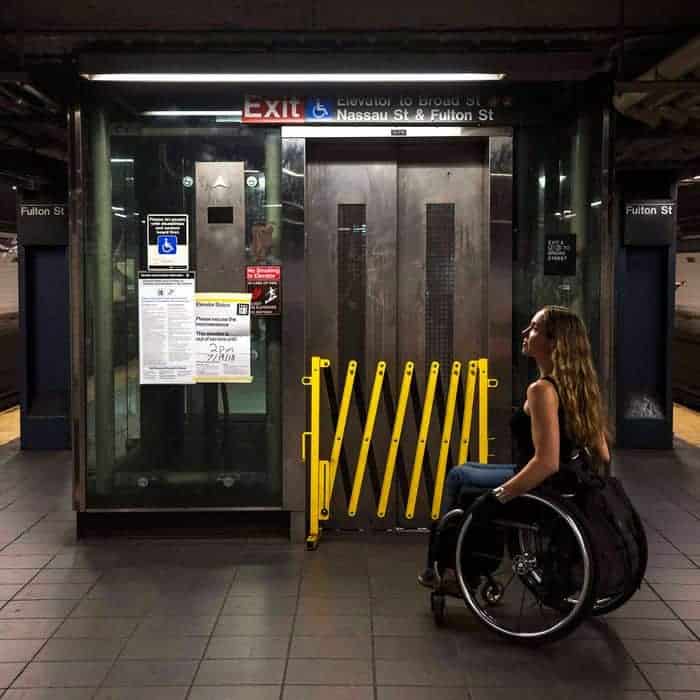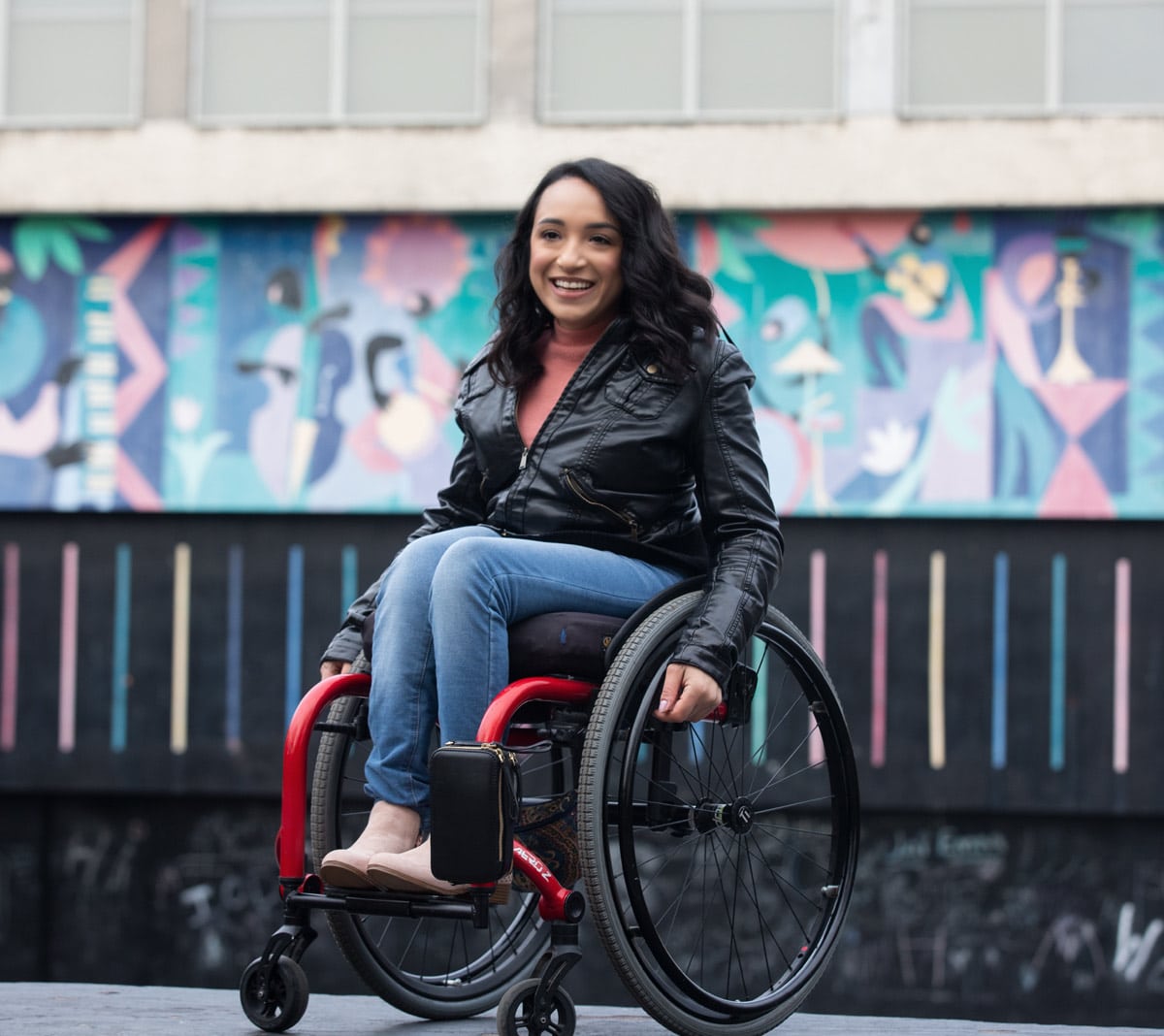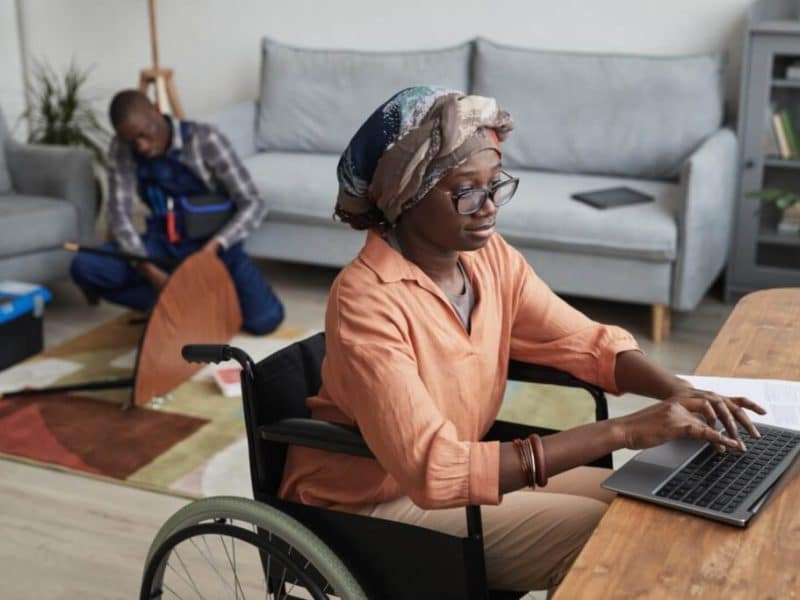
New York City is a difficult city to navigate and reside in for many, but it can be even more challenging for people with disabilities. I moved from Las Vegas, Nevada to Manhattan in the fall of 2019 to attend graduate school at New York University. My mom worried about me, a wheelchair user, leaving the highly accessible city of Las Vegas to move across the country to NYC, but I had found the city to be fairly accessible during my previous visits here. I quickly realized that my prior visits to the city were filled with tourist activities, all of which were built for a wide variety of people and therefore, offered better accessibility. Once I moved to NYC on my own, I soon became frustrated that I couldn’t experience many of the trendy restaurants and bars in my area because they only provided steps, and often no elevators. Further, many sidewalks were uneven, curb cuts (the ramps on street corners) were inconsistent, and the front wheels of my wheelchair would often get caught in the cobblestone streets. Public transportation was hard to navigate and inaccessible and when it snowed it made it more difficult for me to leave my apartment. I was dealing with a new world of challenges I had never before experienced as a life-long wheelchair user.
I am not the only one. Jacqueline Wentworth, an occupational therapist with cerebral palsy who has lived in New York City off and on for many years, has not only struggled herself, but has also witnessed similar struggles amongst her patients who live in New York City. “What’s so hard about NYC, is that it’s created to be a walking city,” she says. Wentworth, though ambulatory, has trouble with excessive walking. “The winter is especially difficult because cold affects spasticity, which makes it more difficult to walk, and the snow slush on the corners of all the blocks…it was an actual nightmare for me.” According to a recent New York Times analysis, 550,000 New Yorkers living in the City have difficulty walking, and two-thirds of them live far from an accessible subway station. Further, only 25% of NYC subway stations are accessible, the lowest percentage of any major transit system in the world, and even accessible stations with elevators have been found to break down at an average of 53 times a year. Public buses are more accessible but require much longer travel time than subways, and other options like rideshare services and taxis, which can be accessible, are more costly.
Yet people with mobility issues are not the only ones facing challenges in New York City. For the hearing-impaired population, captions and subtitles are not always available in NYC. Emily Aronica, who was born deaf, enjoys going to live shows and seeing movies in the theatres, but she says, “There used to be captions—but it’s not as common nowadays and even when they are provided through a device, it often doesn’t work.” Transportation has also proven to be difficult for her, particularly when there are “—unexpected announcements, but there are no auto or manual subtitles made for me to understand.” Further, due to the pandemic, Aronica can’t read people’s lips with their masks on.
Housing is another major concern for people with disabilities living in New York City. NYC is known to have high rent apartments with limited space. According to a recent report by RENT Café, Manhattan boasts the highest average rent in the United States ($4,210/month), three times that of the national average ($1,463/month). In Manhattan, the typicalstudio apartment measures 550 square feet, while the average one-bedroom apartment measures 750 square feet. Limited living space often translates to smaller apartment doorways and bathrooms not sized to fit wheelchairs and walkers. This means that residents requiring these types of aids must be able to afford additionally needed space (i.e. more expensive) apartments. Further, people with disabilities must also consider a housing’s proximity to public transportation, while keeping in mind that few subway stations are accessible.
Unfortunately, businesses in New York City are not fairing much better when it comes to providing accessibility accommodations despite the Americans with Disabilities Act (ADA), which was put into law over three decades ago. This is because the law allows for flexibility, with Title II of the ADA stating that buildings do not have to “take any action that would result in a fundamental alteration to the nature of the service, program, or activity in question or that would result in undue financial and administrative burdens.” Although not explicitly stated in the ADA, many businesses and city governments interpret Title II as the “grandfathering clause” claiming their business is “grandfathered in” when a building is built before a certain year to avoid making costly alterations and to preserve the history of the building.
Yet some other large cities, including Las Vegas, Philadelphia, and Los Angeles, are making headway to accommodate people with disabilities. Andy Arias, a wheelchair user who works in federal policy as a government advisor in Washington D.C. and previously worked in ADA compliance for California, says that L.A.’s accessibility is far more advanced than what he’s experienced on the east coast. “I have never had to call places in L.A. to see if they’re accessible, but in New York or D.C.? Daily!” Arias recalls. “The subways [in L.A.] are completely accessible. We work with advocates, groups, and cities to make sure the subways are flat and anywhere the subway goes, there’s an elevator. Even the gates, they open for us. If you’re in a wheelchair, you wave and the doors open for you. It’s fully accessible,” he continues. “In San Francisco, they have the big buttons on the floor so you can even push it with your wheelchair. It’s very different. If New York was like that, I would probably be living in New York right now.”
Other major cities, like Philadelphia, can also serve as models for improvement. This city provides a grant available to businesses to cover up to 50% of the costs for accessibility renovations. “If an owner doesn’t have the money to become fully accessible, you have to apply for the money of course, but Philadelphia will subsidize the accessibility costs and help you become accessible.” Arias says. “If somebody can’t afford it, then they’ll chip in. People get taxed for it, but I think that’s fair because you’re making it accessible for the city, not just for an individual. I don’t understand why all cities don’t have a program like this.” These are solutions that address the willingness of business owners to be considerate of the 26% of the population that could help expand their businesses and add revenue. “I think disability needs to be looked at as part of our culture…in reality everyone’s going to be where we are in 10, 15, 20 years,” Arias continues. “—People are afraid to look at the reality that disability will happen to all of us.” Arias also recommends instituting tiers of accommodations and a listing of where businesses land in terms of providing accommodations. “If you had a website that was like the Zagat guide of accessibility, where it showed ‘this place is accessible tier 1 or tier 2 or fully accessible,’ I would even settle for that because that would even show that we’re making steps to move forward.”
Clearly, ADA laws are not enough to require businesses to make big changes overnight, but there are smaller changes that can be made in major cities like New York to accommodate disabled people, as demonstrated by San Francisco, Las Vegas, Philadelphia, and others. Arias believes equity for the disability community is imperative to cities prioritizing accessibility. “People need to look at us as equal before it’s really going to change.” Arias says. “Think about it, if your housing is accessible, but you can’t get anywhere with public transit, what good is that? And if public transit is accessible, but you have to live in a $3,000 place then what good is where you’re living? It’s not good. Your community is not whole.”

About the Author: Cheyenne Leonard is a fellow with The Loreen Arbus Accessibility is Fundamental Program, an inaugural fellowship created to train women with disabilities as professional journalists so that they may write, research and report on the most crucial issues impacting the disabilities community.


